It’s fair to say that the Toyota GR Yaris is one of the more disappointing cars in MOTOR’s recent history. That might sound harsh – and it is – but it’s less a reflection on the quality of the car and more to do with the huge weight of expectation it arrived under.
Toyota’s hot Yaris landed in Australia riding a wave of homologation hype, overseas pundits proclaiming it the best thing since sliced bread and a scintillating return to sporting form for a brand that had laid dormant in the performance arena for decades.
No, I’m not forgetting the 86 and the Supra, but they were joint ventures with Subaru and BMW respectively – Toyota is always keen to point out that the GR Yaris is the work of it and it alone.
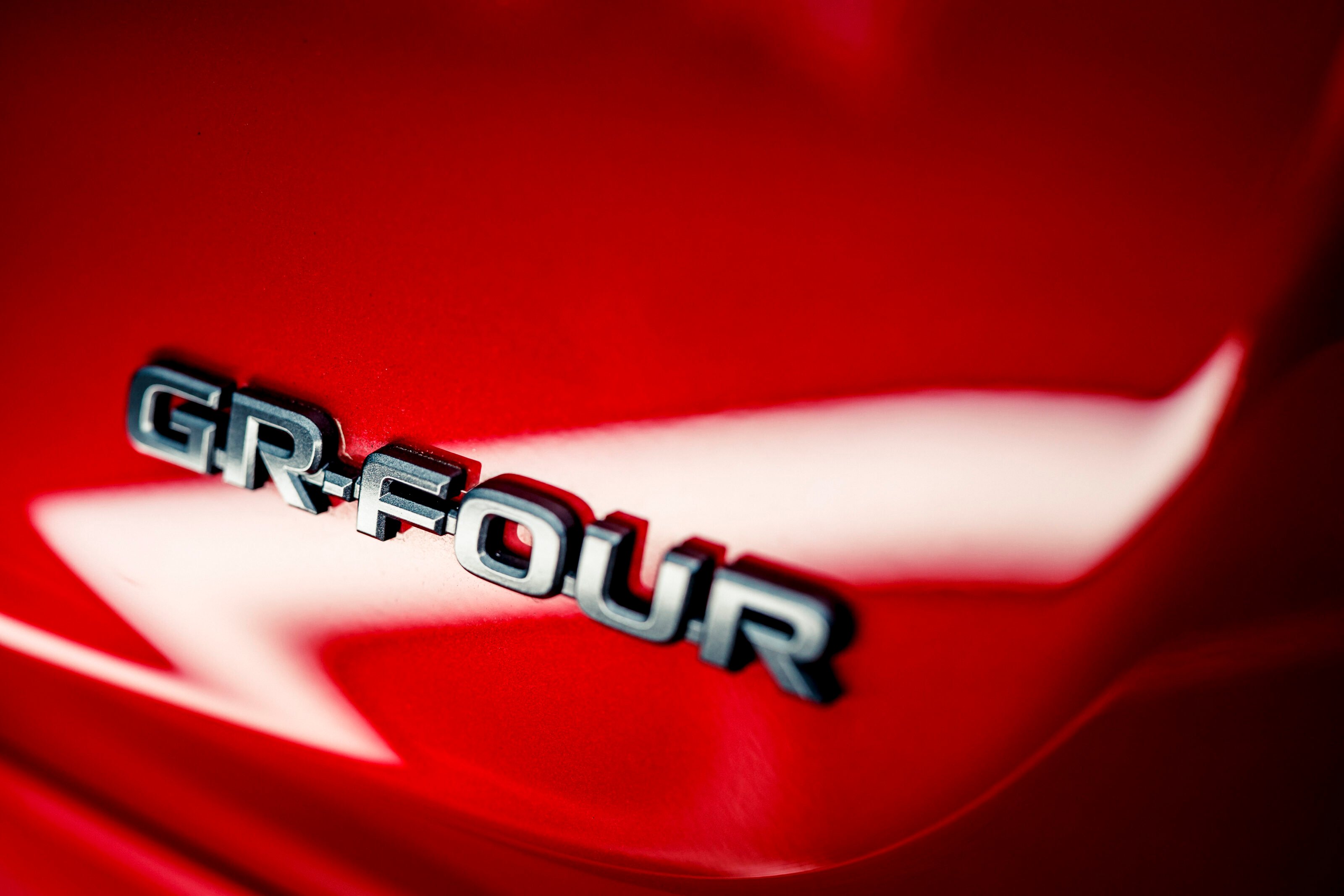
Our first taste of Toyota’s Gazoo Racing hyper hatch on local roads came at last year’s Performance Car of the Year and it’s fair to say that the experience resulted in a lot of scratched heads.
Sure, there was plenty to like about this super-heated baby hatch, including a stonking engine, reasonably slick manual gearbox, fantastic brakes and impressive suspension calibration, but so too was it deeply flawed.
An elevated driving position, front-biased all-wheel drive system and sub-par tyres, resulting in a disconcerting lack of grip, took the shine off the driving experience. Any thoughts that we merely needed to hit the track to allow the GR Yaris to fully express its talents were quickly vanquished by the wails of unsatisfying understeer from the tortured Dunlops.
An unedifying (for all parties) eighth place was the best it could manage, just one solitary point ahead of last place – not exactly the result we expected from one of the most hotly anticipated performance cars of recent times.
“In Australia, the GR Yaris Rallye won’t be a limited production model “
Of course, anyone who’s been following the GR Yaris story will know that, in the words of Master Yoda: “There is another”.
The car that overseas reviewers have been raving about is the Performance Pack, Circuit Pack or, in local parlance, the Rallye, a name chosen to continue the legacy of Toyota’s last all-wheel drive turbo weapon, the Celica GT-Four. It’s now finally landed in Australia, however, the question remains: is it any better?
Let’s start with a quick reminder of what it alters. Externally the obvious cues are the 18-inch alloys, which are lighter than the standard wheels thanks to their forged construction, Michelin Pilot Sport 4 S tyres, red brake calipers, the unique ‘Frosted White’ paintwork, brake ducts either side of the front grille and, most obviously, the Rallye badge on the hatch.
Inside there’s red stitching and Ultrasuede inserts for the seats, as well as a numbered plaque on the centre console. The GR Yaris Rallye won’t be a limited production model per se, but each Australian car will be individually numbered.
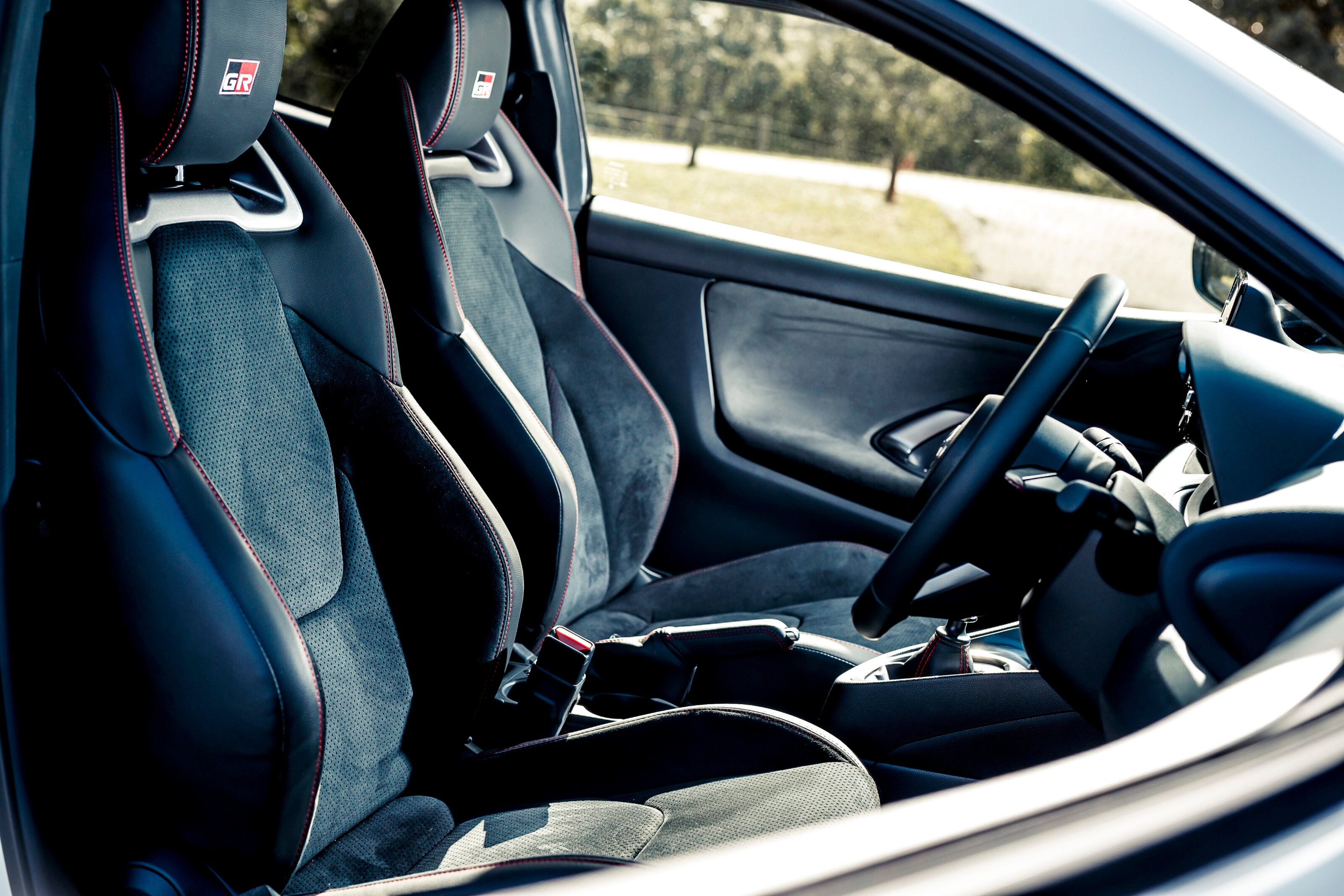
Tucked away out of sight are suspension modifications including larger diameter springs, a thicker anti-roll bar and stiffer bushings at the front and stiffer bearings and bushes and pillow-ball joints at the rear, while the big ticket items are a pair of Torsen limited-slip differentials, one at each end, which allow the engine torque to be distributed not just front-to-rear but also left-to-right.
The ask for these extras is an additional $5000, the Rallye’s RRP set at $54,500, which equates to give-or-take $60,000 on-road depending on your local fees.
In all other respects the two variants are the same, but that’s no bad thing. The standard GR Yaris is already pretty remarkable in its construction, the stiff, light – just 1280kg kerb weight – and aerodynamically optimised three-door bodyshell accelerated by the world’s most powerful three-cylinder engine and decelerated by monster brakes, the 356mm front discs being bigger than those found on the much heavier Supra.

As such the task is a simple one: do the modifications fix the GR Yaris’s handling issues and, if so, are they worth the extra coin? To ascertain this we’ve decamped to the tight, twisting and heavily undulating Bryant Park hillclimb circuit, a favoured venue for testing performance cars that have at least one foot in the real world.
It’s essentially a miniature tarmac rally stage, so should be perfect for providing the answers we need. First I will drive the GR Yaris to set both a time and experiential benchmark, then follow suit in the Rallye and report.
Helmet on, ESP off (even the ‘Expert’ sports setting is too restrictive for circuit work) and all-wheel drive system set to the 50:50 Track mode, initially all is well. The 1.6-litre turbo triple is simply amazing in not only the amount of grunt it generates, but the response with which it delivers it.
Power tails off slightly towards the 7000rpm redline, but the broad spread of torque makes third as quick as second through a number of corners, especially thanks to the close ratios of the six-speed gearbox.
Heel-toe downshifts are no problem, which is just as well as the auto-blip system is too slow to keep up, and while Bryant Park isn’t particularly tough on brakes, stopping power is always on point.
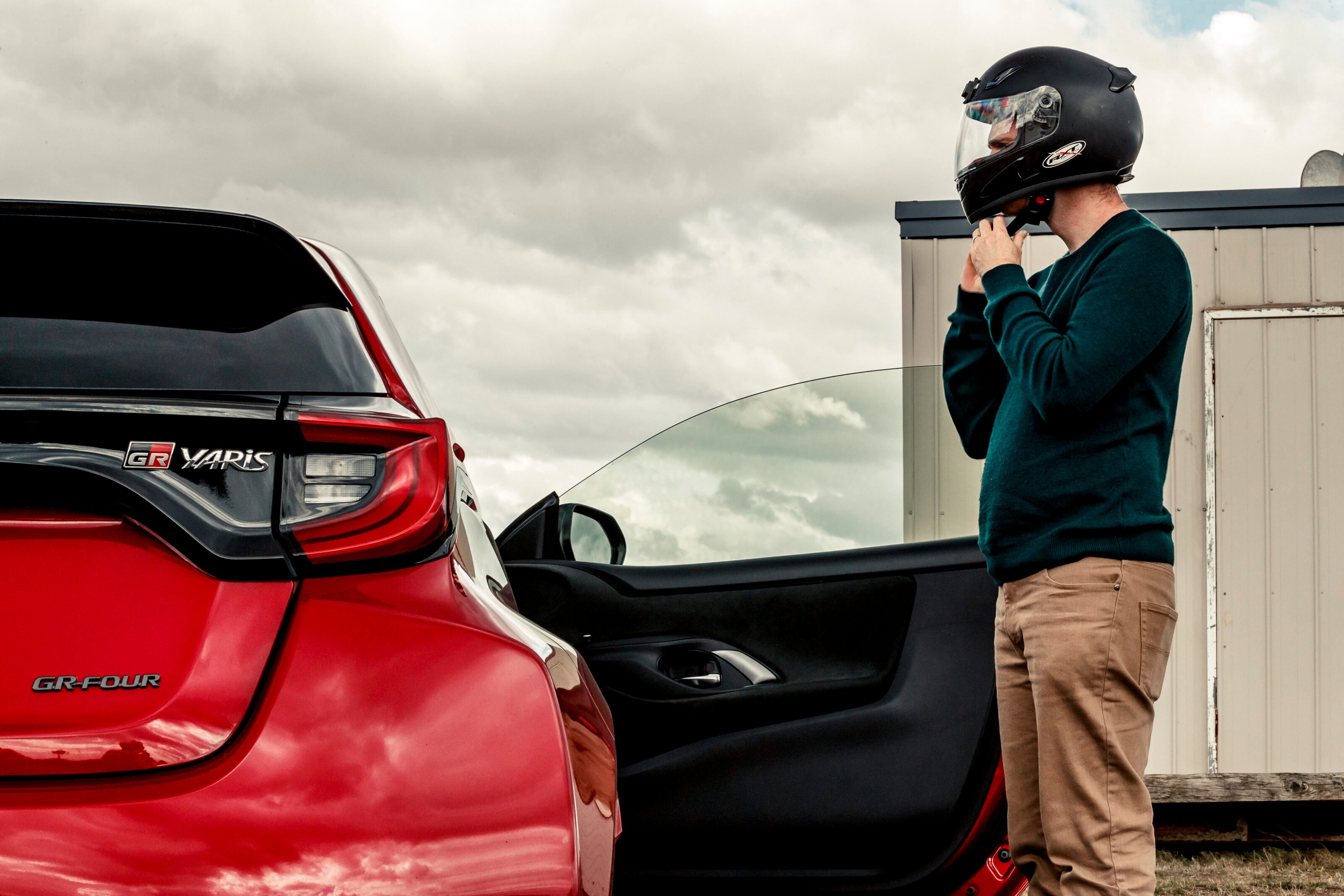
The raised driving position isn’t as bad as I remember, either; there is the initial feeling of sitting ‘on’ the car and being a fraction of a second behind the action but it fades in short order.
Unfortunately, as the pace increases the cracks begin to open wide; the GR Yaris just does not want to turn. The front Dunlops give up so easily that it leaves you unable to commit to corners as once they release their purchase on the tarmac there isn’t much that can be done to bring them back, at which point the road begins to look very narrow.
It doesn’t really matter what you do with the throttle or brakes mid-corner to adjust the car’s attitude, the nose resolutely refuses to stick, leaving the driver with no option but to just wait. At least that all-wheel drive traction will rocket the Yaris from the corner, right?
No. Power understeer is the order of the day, a problem that’s only exacerbated if one of the inside wheels is on the ripple strip and flares into wheelspin thanks to the open diffs.
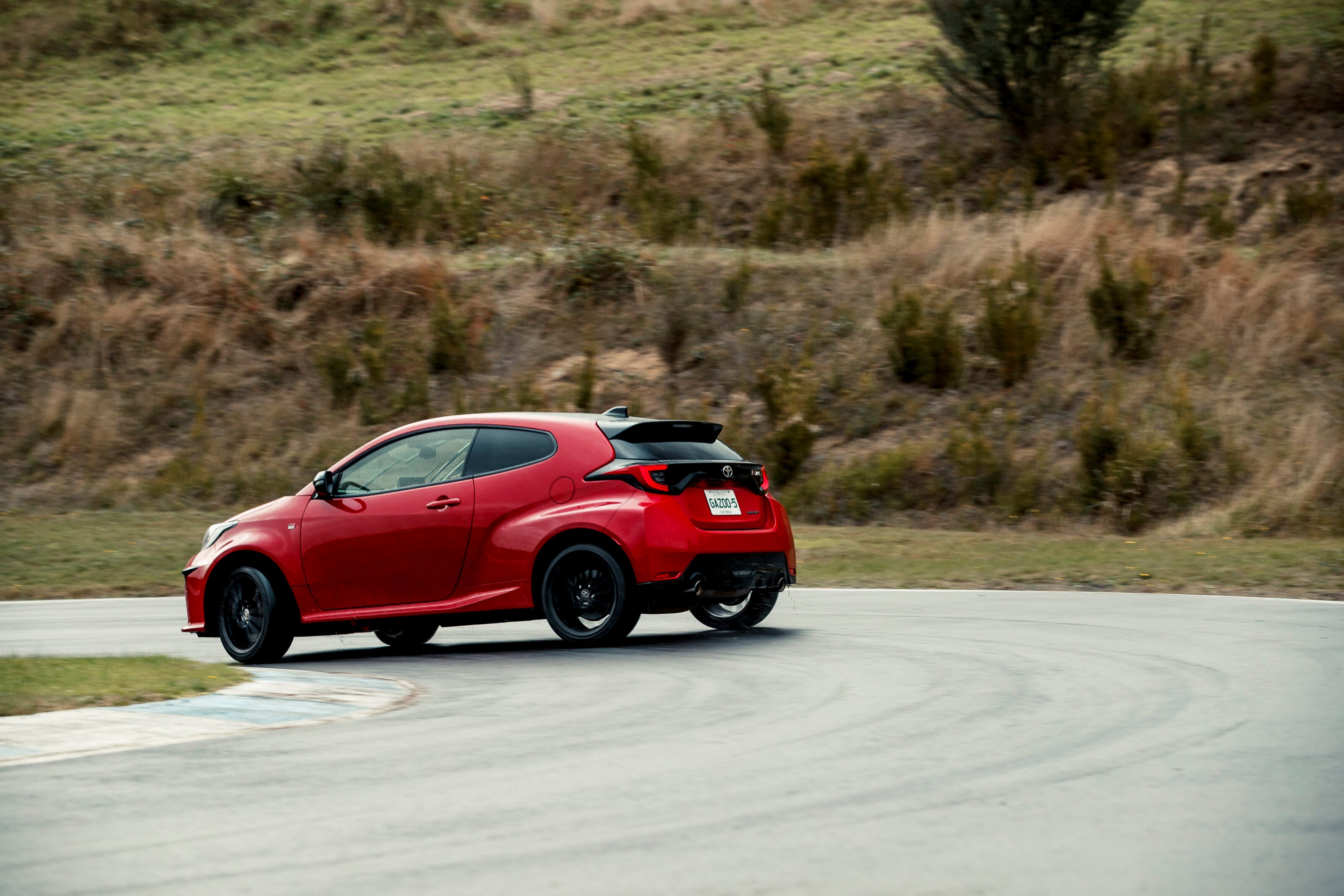
A switch to the supposedly more rear-biased Sport mode (30:70 front-to-rear split) makes little difference and yields just a single tenth improvement for a final time of 1:05.2sec.
It’s not that quick and it’s not particularly enjoyable, either; your eyes tell you that this light, all-paw pocket rocket should be able to be thrown around with abandon, but the only option available is to slow the GR Yaris massively at each corner, which is a long way from the ‘Maximum Attack’ mantra of Toyota’s motorsport advisor, Tommi Makinen.
In case you think this is all the viewpoint of a spoiled motoring journalist who hasn’t had his morning Ferrari, there are actually three GR Yarises present today.
In addition to the two press vehicles our chaperone from the track-owning car club has rocked up in his own black, standard GR. A regular at the track, his experience mirrors ours: “You can’t get it to turn and the open diffs are a big problem.”
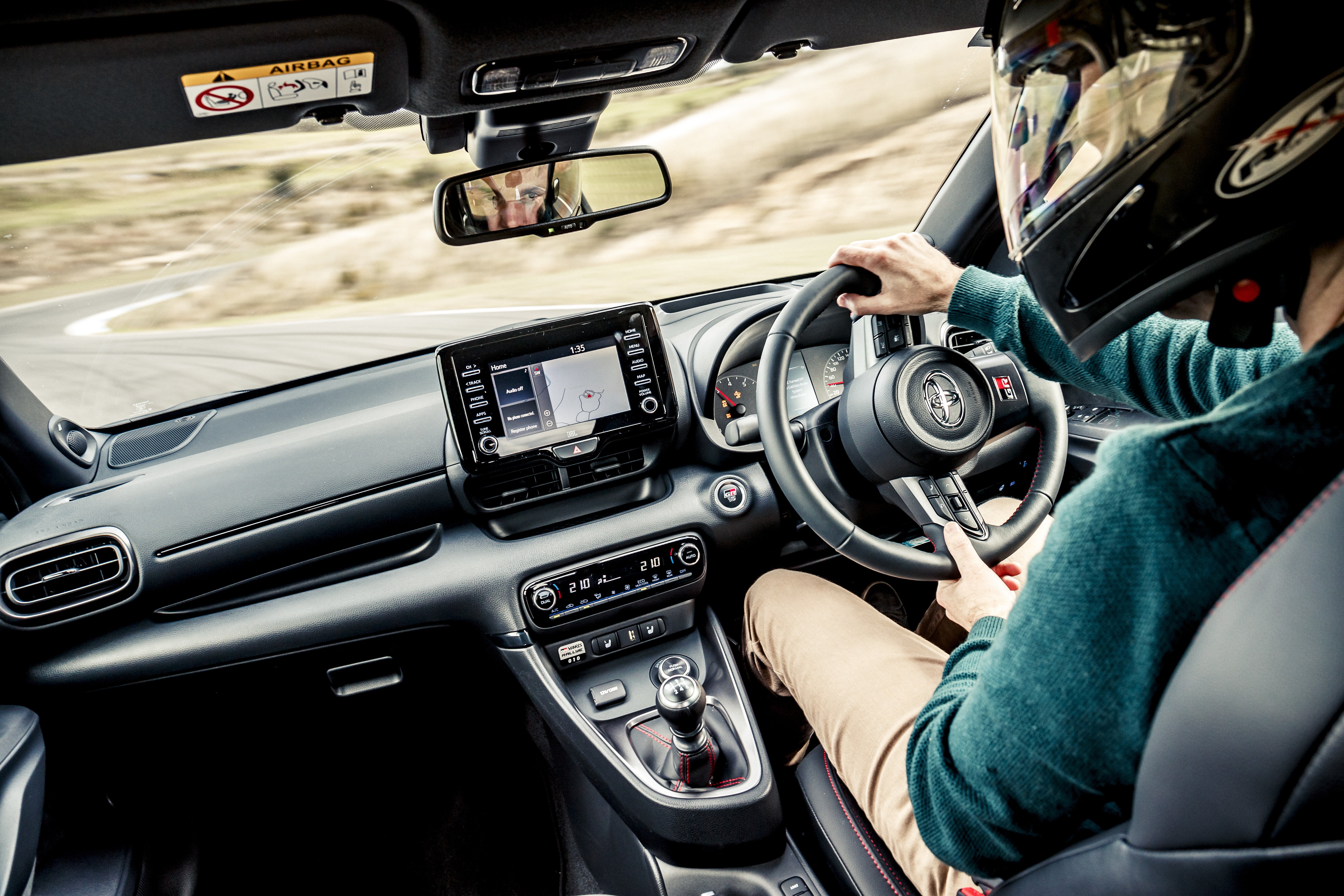
He already has plans to replace the diffs and tyres, but he might be better off just attempting to find a Rallye (the initial allocation is sold but a few cars may still be at dealers, with the next orders set to be fulfilled in late-2021/early-2022).
It takes all of one corner to discover that the GR Yaris Rallye is a completely different kettle of turbocharged fish – for a start, when you turn the steering wheel the front tyres go where you expect them to.
Clearly, the stickier, more performance-oriented Michelin tyres play a major role here but it begins a virtuous cycle.
Suddenly you have the confidence to enter corners harder, safe in the knowledge that there is a safety net of grip beneath you; the extra front-end purchase also brings the rear into play on a trailed brake, which further alleviates the strain on the steer tyres.
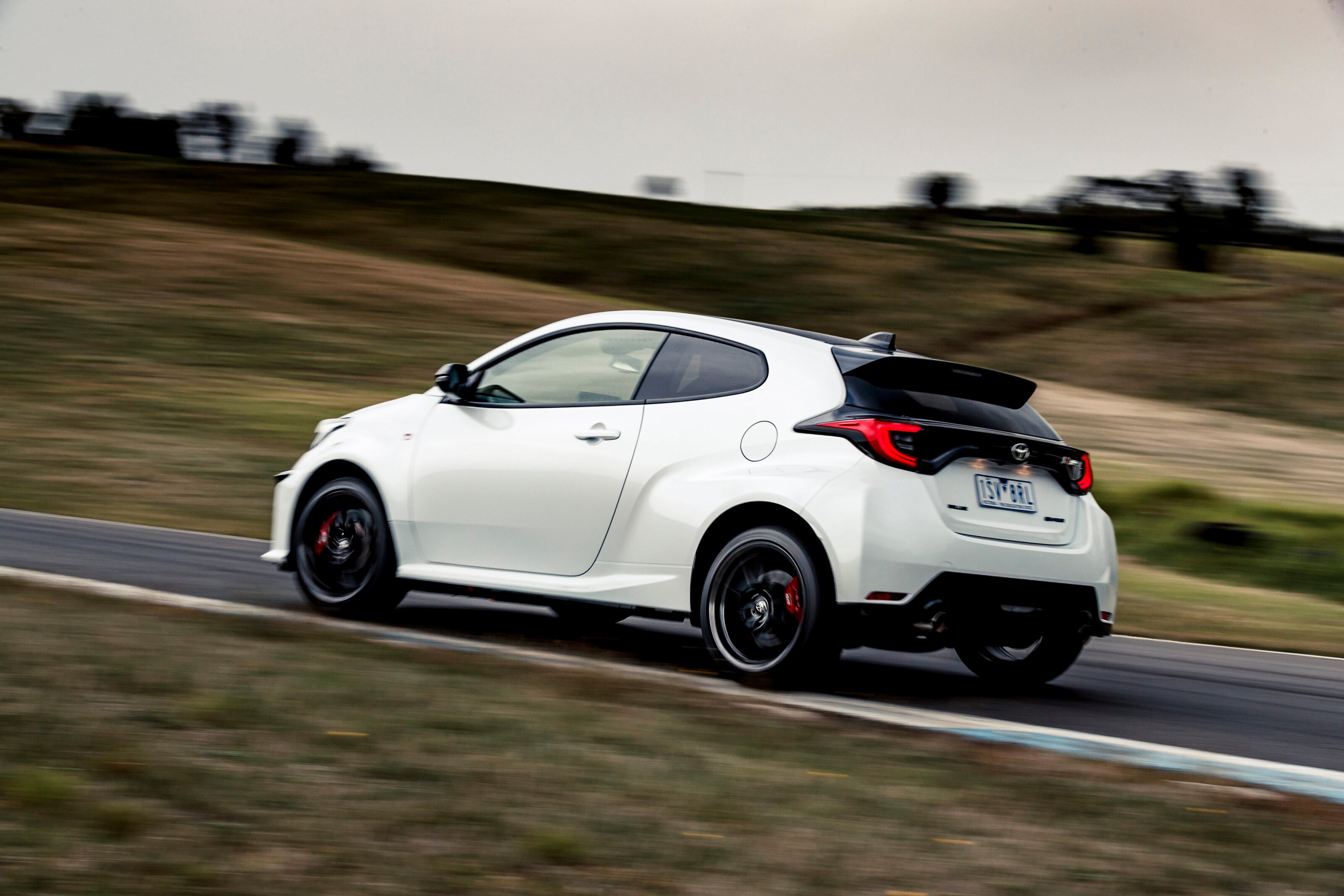
It’s clear at this point that the Rallye is going to be quicker, the only question is by how much, but towards the end of the first lap I greedily accelerate too early and, realising my mistake, back off the throttle quickly.
In the standard GR Yaris this would quell the understeer, but the Rallye abruptly pivots and tightens its line – not only is there more grip to lean on, but there are now options available should that grip run out.
With the diffs spreading the torque evenly across all four tyres – or, more accurately, distributing it to where it will be of most use – the Rallye feels to sink its tread blocks tenaciously into the tarmac.
No longer does a waiting game need to be played mid-corner; the superior rotation makes full throttle a possibility much earlier and while even the Rallye isn’t an on-throttle oversteerer in the fashion of the old Focus RS, nor does it plough determinedly towards the edge of the road like its less-able brethren.
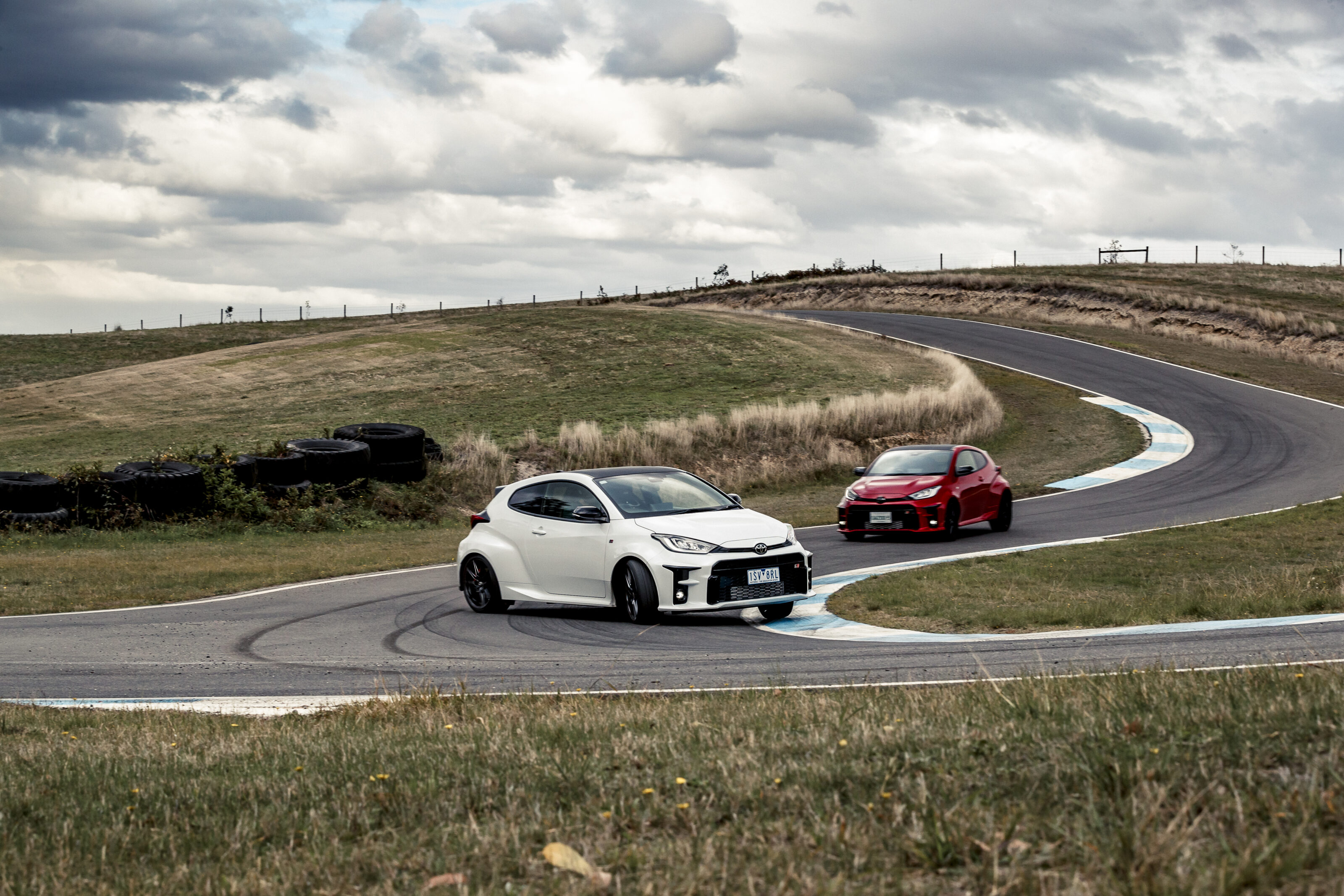
The stopwatch reveals the extent of the improvement. Whereas the standard car was a frustrating wrestle over seven or eight laps in an attempt to coax a tenth or two from the package, the Rallye immediately goes 3.1sec quicker on its first flyer, increases that to 3.2sec on its next two before a final, tidier lap nets a 1:01.8sec result for a total gain of 3.4sec.
That is massive on what is essentially a 60sec circuit and just a tenth behind the time recorded by the Mercedes-AMG A45 S earlier this year.
A look at the data makes it immediately obvious where time is being made – everywhere. In a lot of corners the actual minimum speeds aren’t a million miles apart – sometimes only two or three km/h – but whereas the standard car’s traces are a pronounced ‘U’ the Rallye’s are a nice ‘V’ courtesy of it getting in and out of corners so much more efficiently.
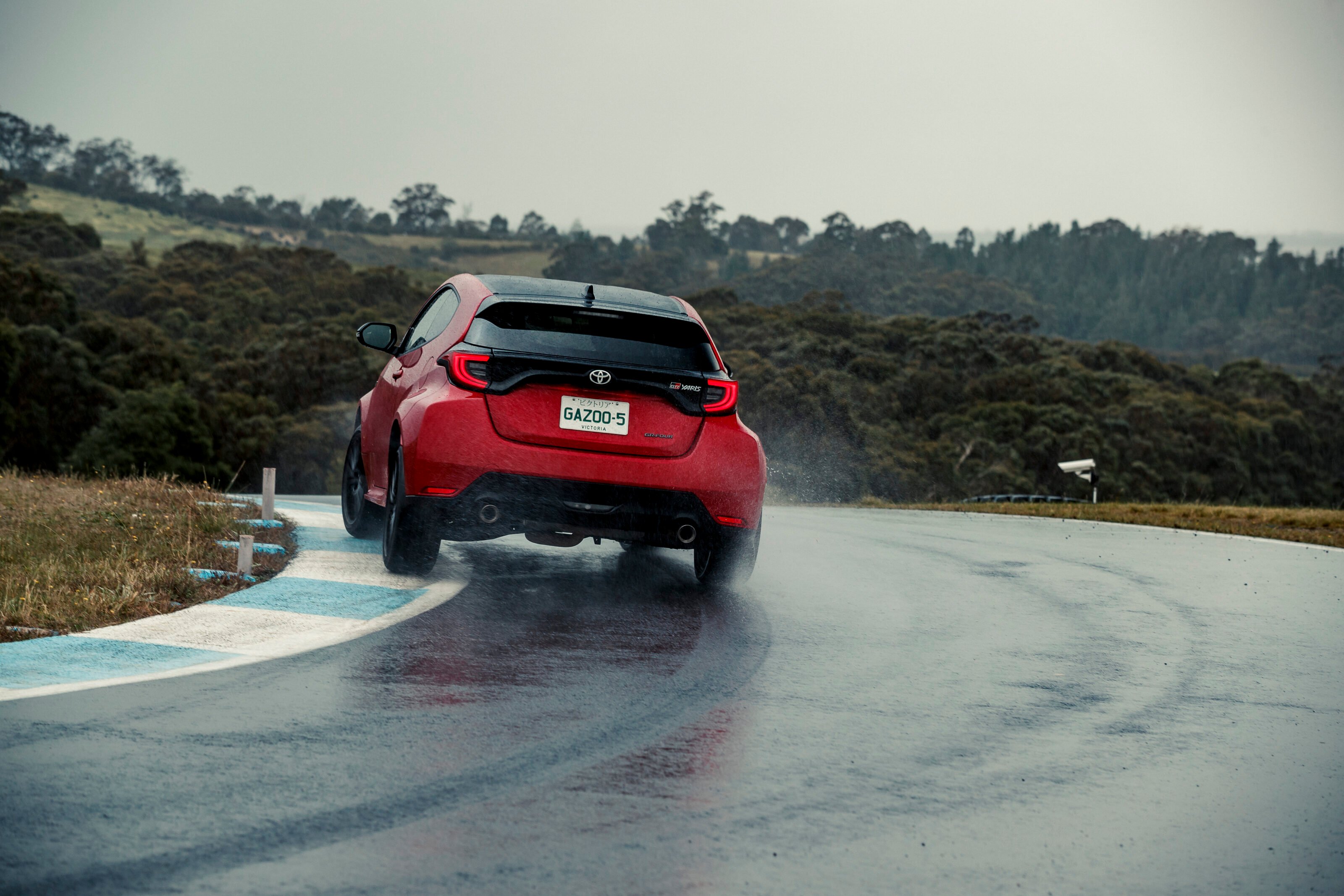
The two cars’ performances are also an object lesson to anyone who thinks adding horsepower is the key to improving lap times.
These cars have exactly the same power and torque yet the Rallye is 4.6km/h quicker on the main straight, 7.5km/h quicker on the downhill run to turn four and 6.6km/h quicker along the back straight purely because it’s accelerating much earlier and from a greater minimum speed.
At this point the main feeling is of relief that Toyota Australia changed its position and managed to secure an allocation of the more focused Rallye version, as it definitely feels like the car the GR Yaris was always meant to be.
The ‘Performance Pack’, as it was then known, wasn’t originally on the table, Toyota saying that the standard car ticked all boxes required for the local market. As this feature shows, it definitely doesn’t, but the Rallye’s markedly improved dynamics, not to mention its greater exclusivity, make the extra $5K spend a no-brainer.
It’s not perfect – the boot is tiny, rear seats heavily compromised, the driver’s seat is still too high, the interior quality is largely budget-basic and its thirst for fuel is prodigious when pushed – but it’s far from being crushed by the weight of expectation, the Rallye shrugs it off and subsequently is a car that very much calls for celebration rather than disappointment.
Lap dance
A lap of Haunted Hills comprises 15 corners and, given what we know of the lap times, the Yaris GR is 5.5% slower than its Rallye sibling.
We sampled speeds at 15 waypoints around the circuit and the Rallye was quicker in 14 of them, sometimes dramatically so.
In most of the slower corners of the circuit the gap was marked at apex.
At the descriptively titled Oh Shit!, the bottom hairpin, the Rallye’s superior turn-in saw it carrying 8.5% more speed at apex.
The steep uphill scrabble of a left-hander onto the back straight is almost perfect for bleeding drive through an open diff and here the Rallye realises a 12% speed advantage, which then levels to a 5.8% advantage at peak speed along that ascending straight.
The final corner, a long right-hand hairpin with no runoff, sees the Rallye cornering 2.9km/h (or 6.3%) quicker at apex, and hooking up better for the lunge to the line.
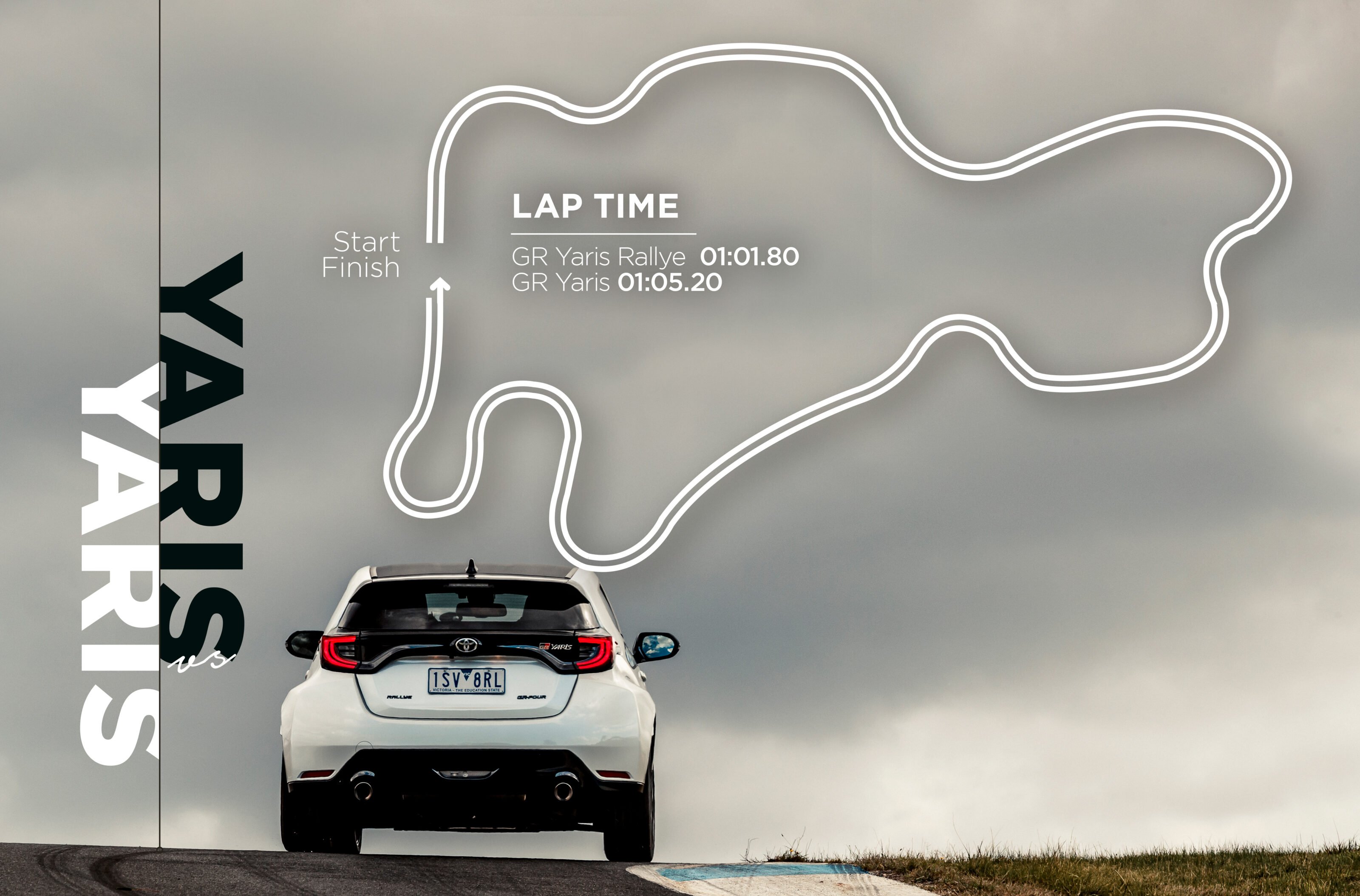
We recommend
-
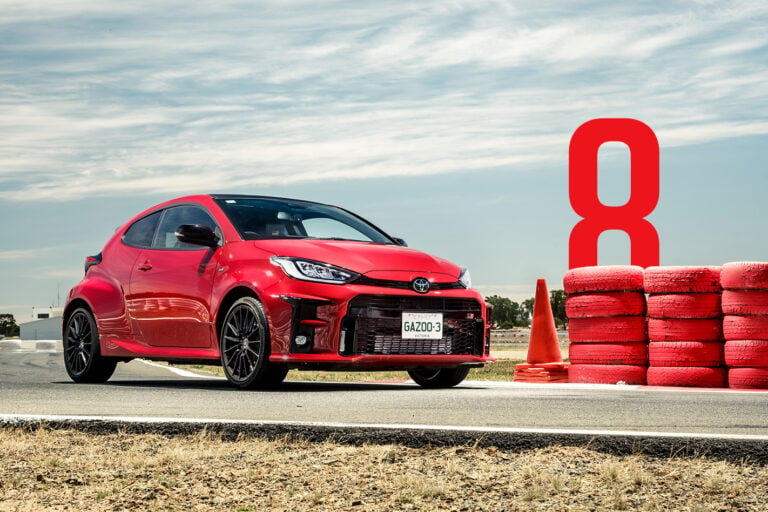 Performance COTY
Performance COTYToyota GR Yaris finishes 8th at MOTOR's 2021 PCOTY
We so badly wanted to believe...
-
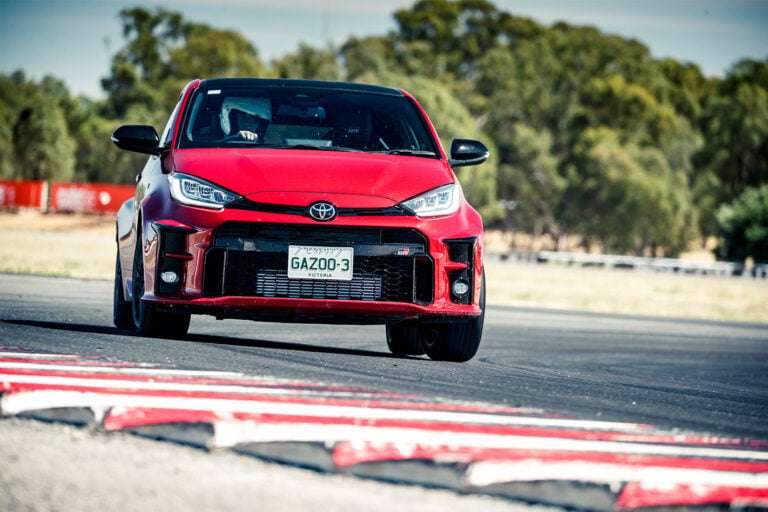 Events
Events2021 Toyota GR Yaris unleashed on the MOTOR Shootout
It’s the car of the moment, but how does Toyota’s star athlete handle the track?
-
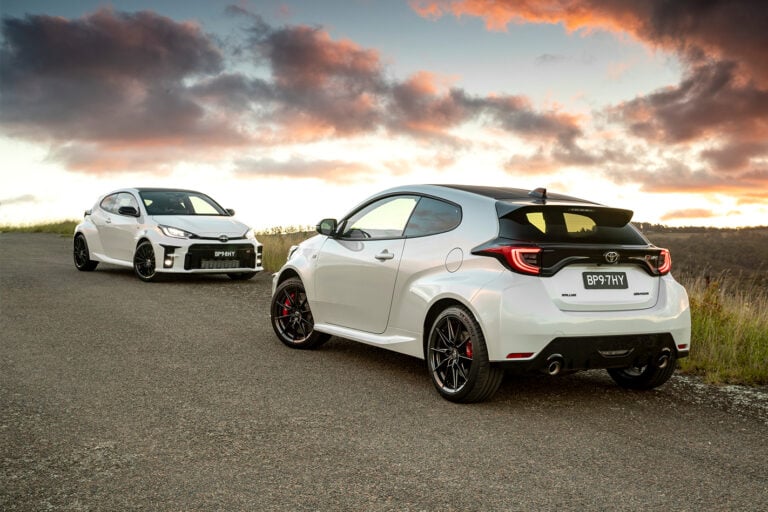 Reviews
Reviews2021 Toyota GR Yaris Rallye review
The full-fat GR Yaris Rallye finally lands Down Under, but does it live up to the hype?





